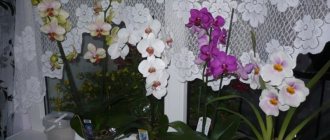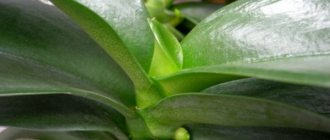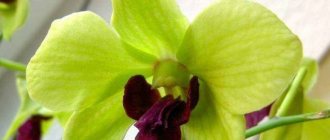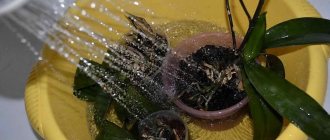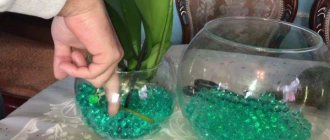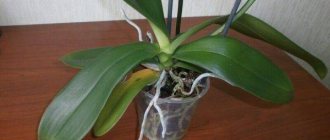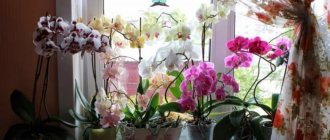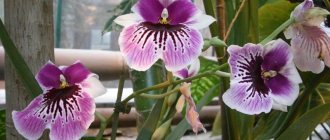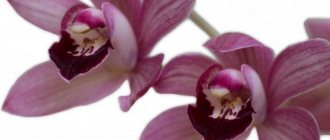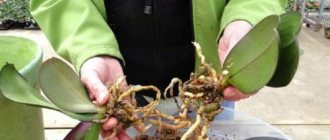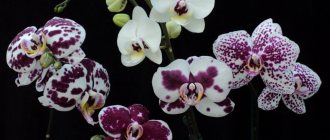What it is?
The name "bulb" comes from the Latin word bulbus, which means "onion" . This organ is a thickening at the base of the orchid shoot, which stores water and nutrients. In many types of orchids, the bulb actually resembles a bulb in appearance, but this is far from the only variant of the form; bulbs can also be:
- round;
- ovoid;
- flat;
- cylindrical;
- fusiform;
- conical.
ATTENTION : The size of orchid bulbs is also very diverse: from a few millimeters to 15 centimeters, depending on the genus and species.
Only sympoidal orchids have bulbs . These orchids with numerous side vertical stems “can afford” to grow special storage organs from several shoots. Monopoidal orchids have only one stem, side stems rarely grow, so they actually have nothing to form bulbs from. Their moisture accumulates in thick, fleshy leaves.
What are pseudobulbs for?
An external inspection of the plant will help prevent disease.
The main function of the organ is the accumulation of nutrients. It helps the plant survive in extreme conditions. Its presence indicates that phalaenopsis develops both in arid conditions and in environments with high humidity. When the plant is given good care, the functions of the pseudobulbs are reduced.
This organ evenly distributes beneficial substances throughout the plant. Its bright green color indicates that it promotes photosynthesis. In indoor orchids that do not have bulbs, the functions of organs storing substances and moisture are performed by fleshy leaves.
When flowering ends, the pseudobulb cannot be cut off yourself: it will still serve as a source of nutrition for new young shoots during the period of their active growth. They wait until it dries itself, after which it is carefully cut off from the very base. After trimming, the cut is treated with activated carbon.
It happens that an old dried phalaenopsis bulb blooms after a while and produces a branch - there is no need to rush to cut it off.
Photo
Below you can see the bulbs and pseudobulbs in the photo.
What are the differences between true and false?
Strictly speaking, there are no differences between the bulb and pseudobulb : they are the same organ, and the difference in names is a terminological convention. Traditionally in botany, the word “bulb” is used to refer to formations that have the shape of an onion, and the word “pseudobulb” refers to formations of any other shape. However, if you confuse the names, it will not be a serious mistake.
There are other, more universal terms:
- tuberidium;
- aerial tuber;
- pseudobulb.
The difference from real bulbs and tubers is that tubers and bulbs are located underground, and bulbs are located above its surface . Strictly speaking, orchids, in principle, rarely take root in the soil, preferring to grow on stones and trees, which are used as “stands”.
IMPORTANT : Many types of orchids grow on trees, but they are not parasites; they receive all the necessary nutrients during photosynthesis, as well as from litter (leaves, fallen bark).
These plants absorb moisture from the air: thick fogs and rain are not uncommon in the tropics. The presence of bulbs is direct evidence of the non-parasitic lifestyle of orchids; true parasites that feed on the host plant (for example, rafflesia) do not need to make reserves.
Development and structure
An aerial tuber is formed from a vegetative bud . First, a young vertical shoot appears from it, then an apical bud grows on it, which, having finished growing, begins to thicken, turning into a full-fledged tuber. This process takes about six months - one flowering season.
In essence, an aerial tuber is a very highly modified stem; over time, buds, both vegetative (with shoots and leaves) and generative (with flowers), can even form on its surface. Often, at the base, these organs have a pair of so-called covering leaves that protect them from drying out and external influences.
The bulb is a “bag” of dense plant tissue - the epidermis, filled with soft mucus-like tissue that absorbs and retains moisture. In nature, orchids use reserves accumulated in bulbs during dry periods. These organs are relatively long-lived: their lifespan varies from one to four years, and in some orchids (for example, plants of the genus Cymbidium) bulbs live up to 12 years.
Types of bulbophyllum
Among almost 2 thousand species of bulbophyllums, it is extremely difficult to identify the most popular ones in indoor floriculture. Nevertheless, interest in some of them is still increased among those who want to add another exotic to their home collection.
Bulbophyllum Beccari (B. Beccarii) - many are interested in this species, but it is difficult to place it in the house due to its large dimensions. The orchid grows in the tropical forests of Borneo, has a thick rhizome with a diameter of 5 to 20 cm, which, like a snake, wraps around the trunk of trees, making its way to their top, to the light.
Along the entire length there are relatively small ovoid tuberidia with a huge thick yellowish-green leaf at the top, shaped like a bowl. Organic residues accumulate in them, which the plant uses as fertilizer.
The inflorescence is formed from a rhizome near one of the pseudobulbs and hangs down, reaching a length of 20–22 cm. The number of small yellowish flowers with red streaks can be more than a hundred. They emit the smell of rotten meat to attract pollinating flies.
Bulbophyllum Beccarii
Bulbophyllum jellyfish (B. medusae) - the plant received its specific name due to its incredible properties with the inhabitant of the deep sea. Tuberidia are elliptical in shape, with one dense emerald-colored leaf formed at their top. The bent flowering stem bears approximately 12 small buds. Opening at the same time, they resemble one large corolla. The sepals gradually narrow downward, turning into thin threads 25–30 cm long. Sometimes they are decorated with scarlet or orange dots.
Bulbophyllum medusae
Bulbophyllum macranthum (B. macranthum) is a miniature orchid up to 15 cm high with a creeping rhizome. Tuberidia are narrow, oblong, forming one leaf at the apex. The flowers are up to 5 cm in diameter, densely spotted - purple merging blots on a white background. The sepals are folded into a boat, and are completely crimson-purple at the end. A distinctive feature is a pleasant, delicate smell that combines freshly cut cucumber with the aroma of cloves.
Bulbophyllum macranthum
Bulbophyllum frostii (B. frostii) is a dwarf epiphyte found in Thailand, Vietnam and the Malay Peninsula. Tuberidia are small, oval, yellow-green in color. The peduncle is formed at the base of the pseudobulb and bears 2-5 flowers, unusual in appearance - they resemble fairy-tale stalks or a chick with an open mouth. The light olive petals are covered with dark purple growths, like warts. The lip is dark cherry, bent with a groove along the central axis. Flowering lasts all winter from December to April.
Bulbophyllum frostii
Bulbophyllum phalaenopsis (B. phalaenopsis) is a large orchid native to the western lowlands of New Guinea with leaves up to 122 cm long, growing from the tops of round pseudobulbs about 30 cm in circumference. A short peduncle grows from the base of the tuberidium and bears an inflorescence of blood-red, pubescent or smooth flowers 7.5 cm in diameter, which emit the smell of rotting meat. Fortunately, it is not very strong and is only felt very close to the plant.
Bulbophyllum phalaenopsis
Bulbophyllum bicolor, or two-color (B. bicolor) is a tiny orchid native to Hong Kong, growing no more than 13 cm high. The pseudobulbs are elliptical, no more than 2 cm in length, barely exceeding 1 cm in circumference. At their top, one narrow oval-shaped leaf is formed , approximately 11 cm long.
A peduncle 4.5 cm long grows from the base of the tuberidium. The inflorescence consists of 3–5 beige flowers, the petals of which are dotted with thin bright scarlet lines located longitudinally on the surface. The lip is yellow or coral. The orchid blooms at the end of winter, in February, and pleases with its flowering for 2 months.
Bulbophyllum bicolor
Bulbophyllum Lobb (B. lobbii) - named after the English traveler and botanist T. Lobb, who brought the plant from Southeast Asia to the UK. An orchid of medium height - about 30 cm - with yellow-green ovoid tuberidia and leathery leaves approximately 25 cm long.
The peduncle grows from any node on the rhizome and bears one large flower with a diameter of 7-10 cm, considered the most beautiful among plants of the Bulbophyllum genus. Sepals and petals are pointed and slightly curved, their main background is usually yellowish, but can also be orange or light olive. Dots and streaks of pink, dark cherry or purple hue are scattered across the entire plane of the petals.
Bulbophyllum lobbii
Bulbophyllum woolly-lipped (B. lasiochilum) is a plant native to Thailand. The pseudobulbs are elongated-oval, the leaves are elongated-obovate. The flowers are small, fragrant, approximately 3 cm in circumference, collected in an umbrella inflorescence. The sepals are yellow or fawn with scarlet spots, the petals and lip are fleshy red.
Bulbophyllum lasiochilum
Bulbophyllum Rothschild (B. rothschildianum) - got its name in honor of British orchid collectors. The plant is practically never found in nature; several specimens were found in northeastern India. A low flower about 20 cm, it is distinguished by the fact that it grows as a bush and produces several increments per season.
Pseudobulbs are up to 4 cm long, each forming at the top a single leaf of dark emerald color no more than 18 cm in length. The arched peduncles bear an umbrella inflorescence of unusual skirt flowers formed by lateral sepals covered by an upper petal-hood. The edges of the corolla are elegantly decorated with a variegated fringe of ribbon-like fibers, swaying at the slightest vibration in the air. The main background of the petals is light green-white, but along their entire surface they are studded, like beads, with crimson-scarlet tubercles.
Bulbophyllum rothschildianum
Bulbophyllum careyanum is an epiphyte approximately 25–30 cm tall with light green oblong pseudobulbs and linear leaves. The inflorescences are cylindrical in shape, about 20–25 cm long, and consist of small orange-yellow or greenish flowers with a pleasant, moderate smell of overripe fruit.
Bulbophyllum careyanum
Names of plant species that form pseudobulbs on the stem
As mentioned above, only sympodial orchids form aerial tubers. Therefore, if your plant is of this type, it will certainly have bulbs.
lelia;- lycaste;
- maxillaria;
- Dracula;
- biphrenaria;
- pescatorrhea;
- promenea;
- Cattleya;
- hell;
- brassia;
- dendrobium;
- bulbophyllum;
- oncidium, as well as many others.
Care
Orchid bulbs do not require special care . The only thing you need to remember is that the tubers, like the roots, are very fragile, so you should not touch or move them unless absolutely necessary. It is also undesirable to leave the bulbs in bright sunlight. Rare types of orchids tolerate direct sunlight well; most begin to dry out, and on some the sun can leave a real burn.
The health of a houseplant depends on its root system. And most orchids have aerial roots. Why they are needed and why they grow upward, how to awaken dormant buds, care for the shoot during flowering and raise the baby on the peduncle, as well as what is a growing point and what are the reasons for its absence - read on our portal.
Diseases and pests
Oncidium, like orchids, is often susceptible to pest invasion. It could be a scale insect, a mealybug or a fairly common mite. If you notice a foreign body on a flower , you should remove it with cotton wool soaked in soapy water or alcohol.
Next, you need to treat the flower with a special anti-pest preparation. This is actellite or actara. Instead of industrial products, you can use folk remedies - prepare a garlic or onion infusion. To do this, add a spoonful of chopped vegetables to a glass of water and mix well. You need to leave the mixture for a day and then apply it.
Important! Often housewives do not know why oncidium dries out the peduncle. This problem can be caused by improper placement of leaves, which slow down its growth.
In addition to pests, the flower can be affected by fungal or bacterial rot . Due to waterlogging, the roots begin to rot. The same thing happens when placing oncidium in a draft or wind.
If you notice brown spots on the leaves of a flower, this means that the plant has been affected by bacterial rot. should be immediately removed and the flower moved to a warm, ventilated room. You can also treat the plant with a fungicide.
